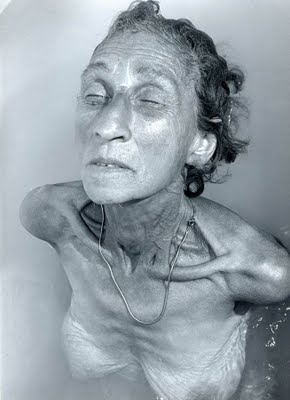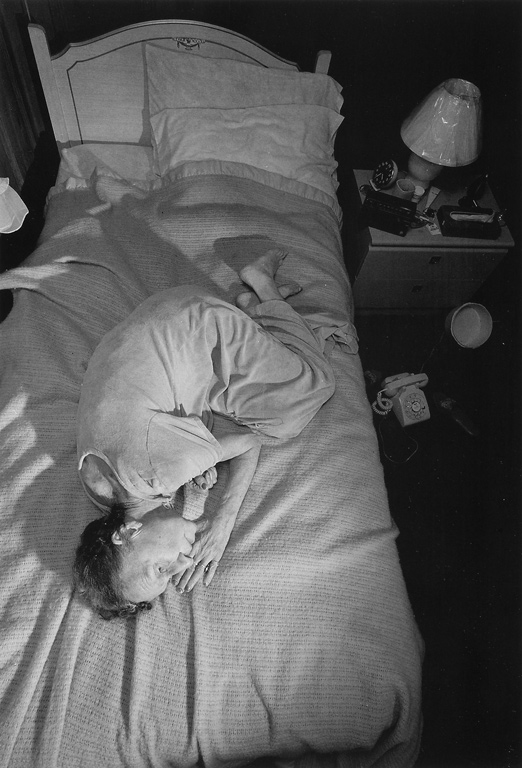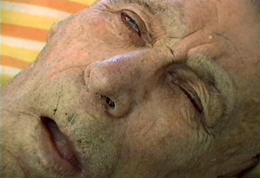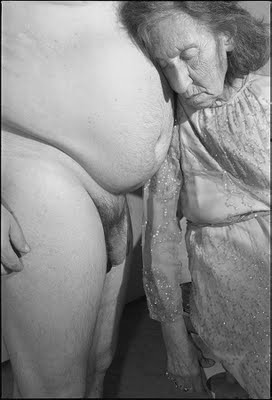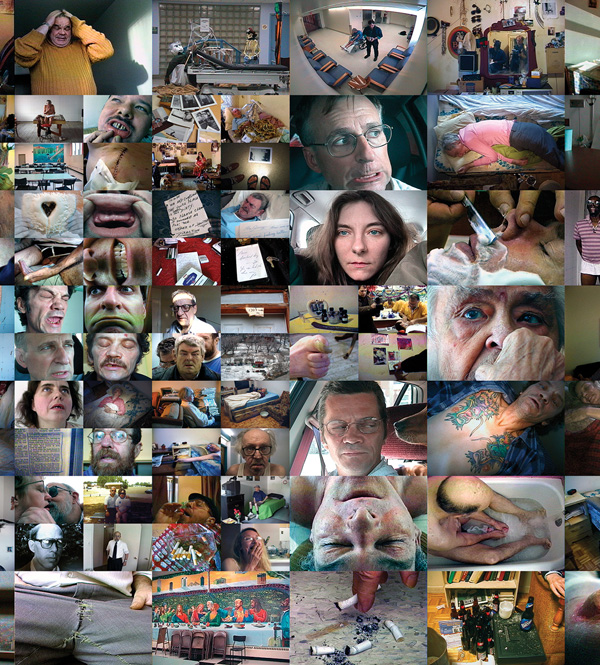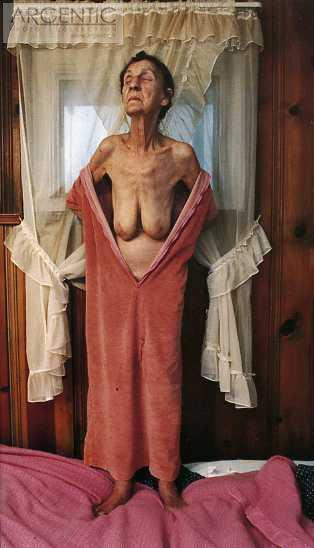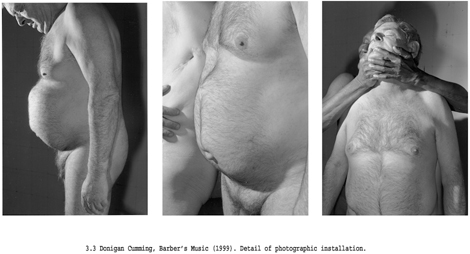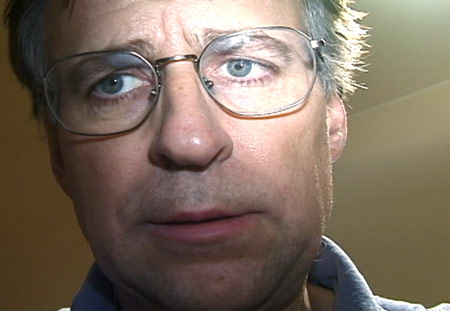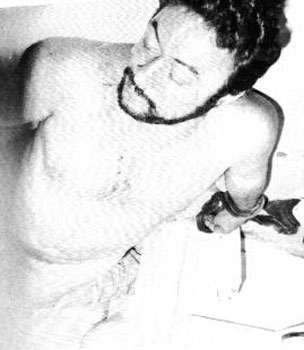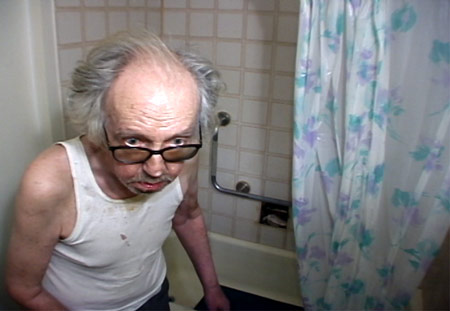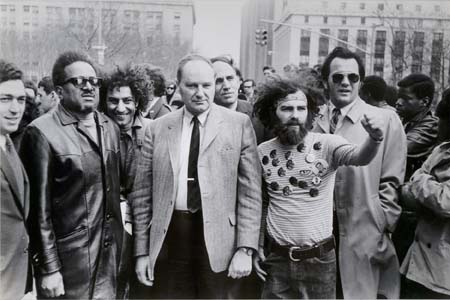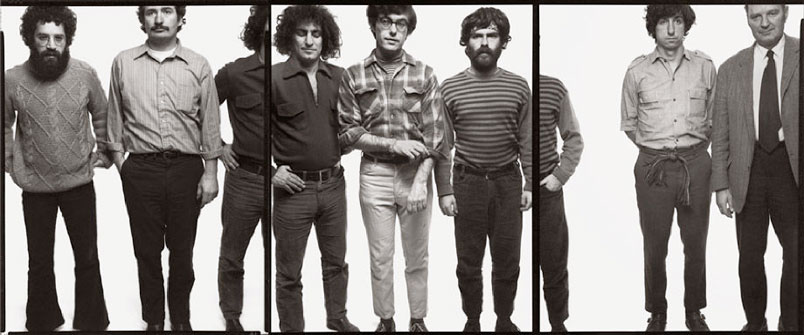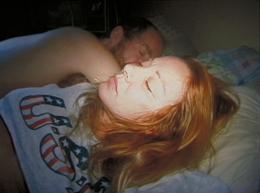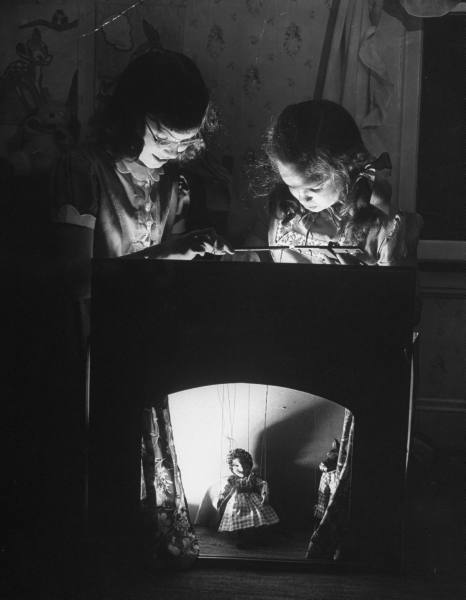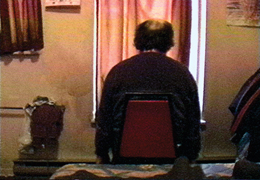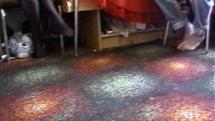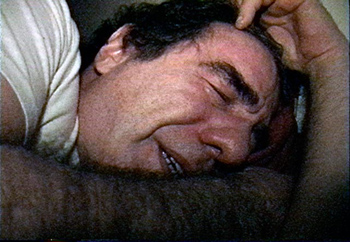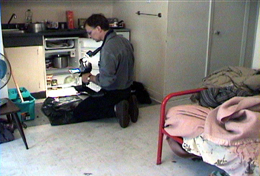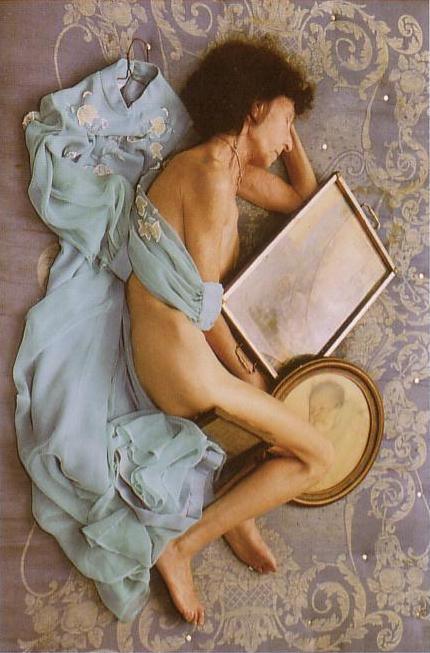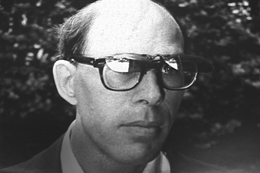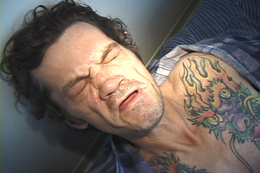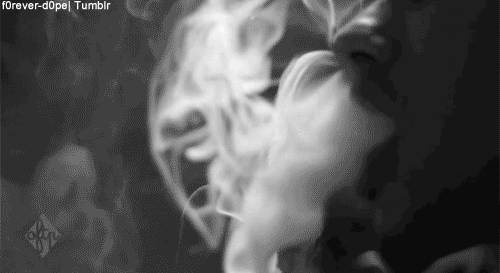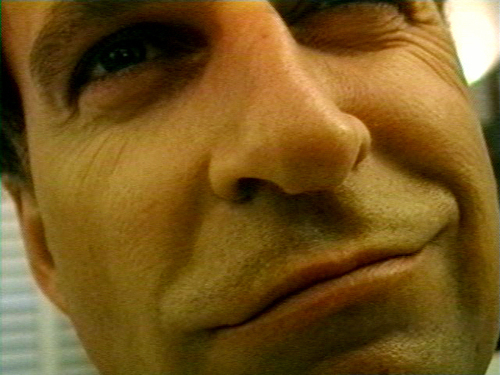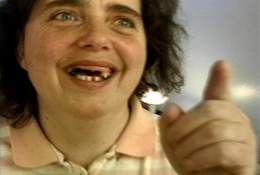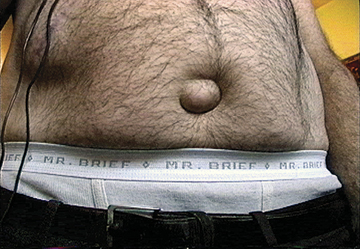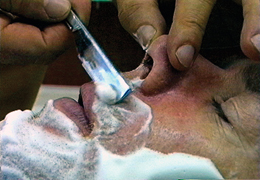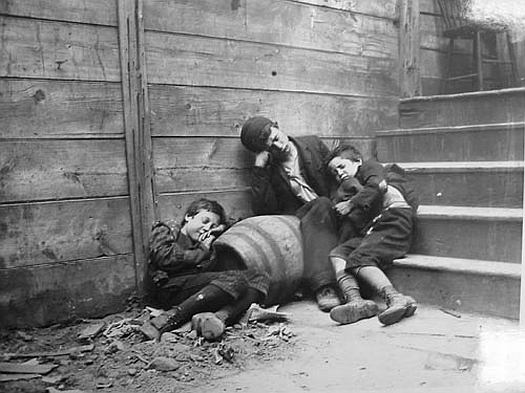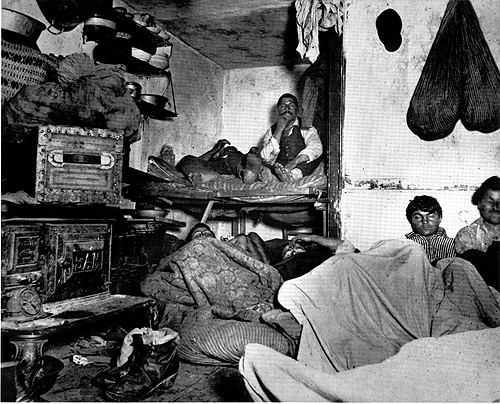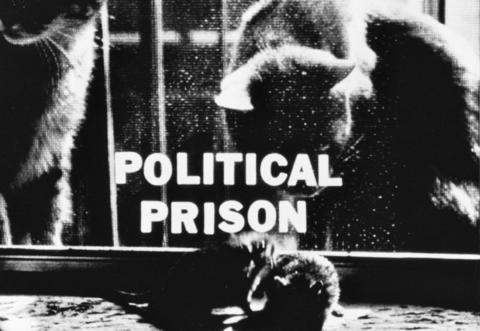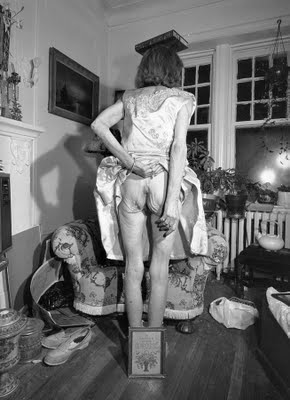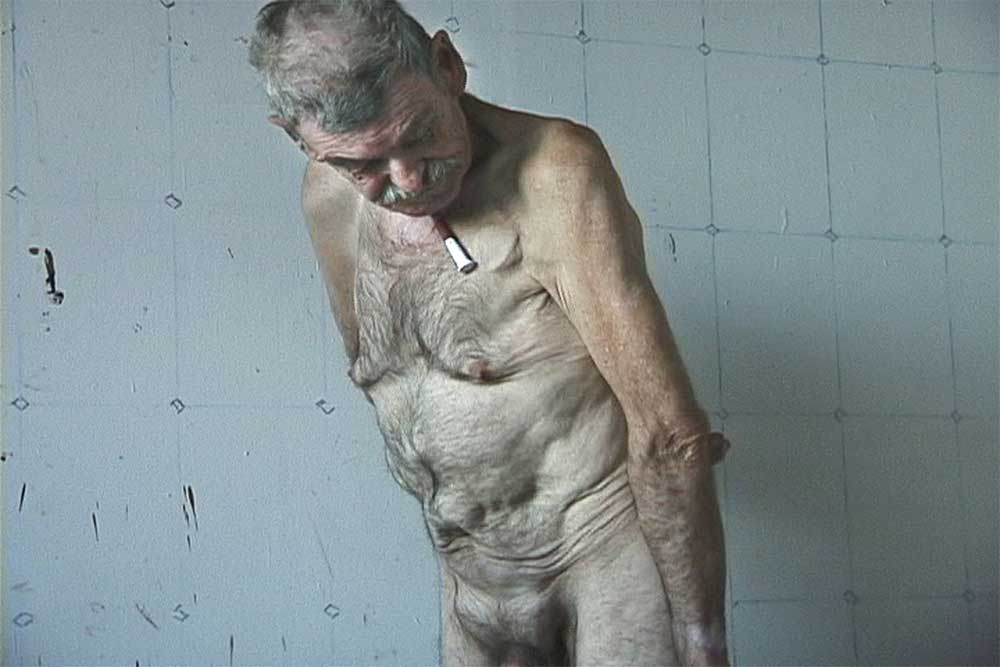
After Beauty
Steve Reinke had tipped me to Donigan’s existence, like a detective in a foreign country pointing out one of the locals with a nod of his fedora. That one, he might not look like much, but he’s one of us. Not that Steve would ever be so crass as to speak in the third person. But I was already primed when they rolled out the easy chairs. Where was my Donigan virginity lost? I had dutifully ignored his decades of outsider photography and stepped up only for his opening video memorial work A Prayer For Nettie (1995). As soon as it started, with its harsh lighting and sub-optimal camera microphone sound, and most of all the infuriating tendency of the director to hand hold everything in a wobbly, amateurish paroxysm of anti-spectacle, I closed my heart. No please, not in my avant living room. His subjects — uniformly poor and disheveled and alcoholic — seemed like furniture props for the director’s slumming projects. Oh yes, I used to raise a glass of cheer with you, but now I’m on the way up, and you are the necessary ladder rungs to take me there. Don’t mind my camera boot heel in your face. And don’t think you’re going to be memorialized or anything. What do I look like — Walker Evans? Dorothea Lange? Everything they touched was silver happiness, they could stand their subjects up in front of the worst day of their lives and make it glitter with the kind of truth that makes collectors reach for the deep folded green. But Donigan? It’s as if he’d never heard of silver, and so his subjects — already worn by years of living on the Titanic, still running the self immolation derby that began before the beginnings of memory — looked like they were trying on a last testament, one final pit stop before saying yes to the death drive. Their surgical scars appeared unadorned in the harsh, digital video contrast, their wattled skin like the camouflage of jungle fowl trying to escape notice, their sinking flesh long ago surrendered in a losing fight with gravity.
I was waiting for beauty — even of the abject sort dished up by edge dwellers like Witkin or social justice photographers — who illuminated the overlooked and unwanted in a silvery skin. In other words, I was looking for a shield, for something I could put between myself and the subjects of this work. Surely there must be some kind of consolation (the mastery of tones, the perfect composition, the uncanny intersection of emotive gestures frozen in an instant of narrative collision). Donigan refuses all this. Instead, he pushes his low-fidelity camera into the vanishing faces of his company, mercilessly and without adornment, or even the traditional cinematic easements of triple take grammars and reaction shots. If he was a boxer he would be a slugger, loading up the same punch round after round. Take this, and this and this. When Cocteau quipped that in the cinema we are watching death at work, he might have been describing these encounters.
How helpful for the artist to present to me with the unwanted gift of my own looking, my own point of view. Without the balm of traditional virtues, and all that virtue manages to keep secret, I am confronted by my own wishes and need to look away. My taste. Judgment means what am I willing to swallow, and Donigan serves up dish after dish, until I need to reconsider again the words Freud laid down in an essay he named Negation.
“The judgment is, ‘I should like to eat this,’ or ‘I should like to spit it out’; and, put more generally: ‘I should like to take this into myself and to keep that out.’ That is to say, ‘It shall be inside me’ or ‘it shall be outside me’… the original pleasure-ego wants to introject into itself everything that is good and to eject from itself everything that is bad. What is bad, what is alien to the ego and what is external are, to begin with, identical.”
How can I know who I am unless I can start spitting things out of my mouth, and deciding every time I do: not me, not me, not me, until at last a vague outline takes shape. I would be nothing without my dislikes, my familiar prejudices, my reliable oppositions. National identities, of course, are founded and founder on exactly the same lines. What is a newspaper but the sound of nations spitting each other out?
The Donigan movie that turned the corner for me was Karaoke (3 minutes 1998). The camera draws a bead on its subject, bedridden Nelson Coombs, who appears to have mastered the final posture in every yoga setting, savasana or corpse pose. There’s a folk song playing, a home brewed cover version sung out by Nelson’s girlfriend’s friend, and then accompanied by unseen singers in the room. A wobbly pan runs down the remains of his body, and then the whole thing plays backwards, as if Nelson were a living palindrome. I have a weakness for palindromes, ever since Owen Land worried them in movies like No Sir, Orison (1975) or Wide Angle Saxon (1975), figuring them as necessary preconditions for the conversion experience he held out as the hope of every avant seeing. While I shuddered at Donigan’s make shift pan, longing instead for some dolly tracked, steady as she goes framing, there is an undeniable power in this seeing, and just as Mr. Land might have hoped, my conversion into a Donigan acolyte had begun. The punchline in Karaoke’s single shot encounter arrives in the middle of the tape — exactly where one might expect to see it, given its symmetrical construction. The crux is in the fold, the crease, after which the tape backs right up and does it all again. What is revealed in this moment? Nelson’s toes! Nelson’s toes are moving! Until then the body appears dead, and the insistent closeness of the camera implies some terrible intimacy between viewer and viewed, some prior relation which has brought this anguished proximity to bear. It’s as if the camera wanted to plunge into this body and see every organ and protein redistribution centre and bone marrow replenishment. It just can’t get close enough to register the fact of the death of this strange familiar. But then I see those toes moving, signaling not only life, but some form of pleasure, a pleasure so large and strange and unworldly that even the dead are compelled to tap their toes to this Inuktitut cover song.
My taste and the experiences that I spit out of my mouth (that’s not me!) had been reborn along with Mr. Coombs. Somehow the artist had managed to broaden my acceptable experience, what I could imagine as myself, or for myself (as if I was always up for election, and every object in the world was voting: this is for me, this is not for me). It is the toes of Nelson Coombs that provide the turn. The mirror fold of the movie occurs at the end of his body, at the bottom of it all, the base in every sense of the word, that is mostly kept under wraps. Locked up in a clinch with this nearly dead and supine body, starved and scarred and hardly there, I learn something new about the pleasures of the flesh. Even until the last breath there is the possibility of celebration, of dancing, even carrying the tune. There’s no future and it doesn’t matter.
I met Donigan at last at the closing dinner of the Nyon Festival in Switzerland, a staff-only love-in for its charismatic director Jean Perret. Each of the special guests — as we were described — was asked to do something for the occasion, and while my own contribution is lost even to memory, Donigan engaged Jean in a short skit that involved the A fest director sitting up on his chair and barking like a dog. It was charming and cruel and hilarious at the same time, the loving trust between the two of them palpable. I resolved to look deeper into Donigan’s work.
The next year in Nyon he presented Fountain (22 minutes 2005), a movie premised on his book Lying Quiet (2004) which presents a sequence of video stills. His strategy in producing the book was to take his 143 hours of raw footage and divide it by the number of stills required for the book, approximately 500, which gave him a figure of 17 minutes and 7 seconds. At this point in every tape he would stop and create a frame grab, allowing a second on either side for closed eyelids or pan blurs. These were then intuitively arranged into a final selection of 119 pictures. Using the book as a kind of script, Fountain revisits his work, producing a kind of greatest hits, a quickly paced theme song of despair and decay, not ‘over the top,’ but under the bottom. The faces of the underclass loom into the lens in these up close and personal encounters, whether it is the man who wants to put bars near the toilet to help his father (though it is Donigan who knows that the problem is a broken shoulder, not a broken arm), or the salivating ungrand dame on the oxygen tank, the Elvis send up, the stuttering actor, the toothless display, the home sewn pants, the corner of an uneaten sandwich. Fountain is an accumulation of details that graze across its rooming house interiors, each one a punctum, a piercing point that plunges into the thick and gristle of these usually forgotten and unpictured lives. Like the paper airplane that reads Jesus is my Pilot. Interspersed between the extracts is Donigan’s voice directing his charge, urging them on, reading them letters, asking about their legal status, their health, their parents. He is with them and not with them, holding the camera but refusing to vanish behind it. Instead, he stays in the room with them because the only way to bear witness is as an active participant. Death is never far from his lens. There are hospital visits and memorial photos and sleepers who look like they may never see another morning. Donigan’s engagements throw him into the damage of these difficult lives, and refuses to put ‘them’ over there, on the other side. He doesn’t spit them out. His subjects are a part of him and apart from him, in frame after frame he negotiates this distance, which is the magic of his work as an artist, to find the necessary distance between his life and the lives of those around him.
At last we sat to talk in the shadow of foreign mountains, and he was blunt and smart and didn’t come with an off switch. There was something soft in his face that the rest of him nearly regretted. It was clear he’d been hurt, cut hard and deep and often, and instead of bearing off his wounds in silence and re-encoding them in the catastrophe of family genetics or substance sprees he’d decided to wear them up on his face where everyone could see it. Donigan has a face that hasn’t learned the knack of looking away, in fact, when the usual electric pulse signals flight he seems to draw closer. His world, his ethics and art, all happen in close-up, as he casts his wound of attention into mine, trolling for secrets, and then abruptly pulling away, retiring back into his emotional force field of WASP reserve, near and far, fort und da, back and forth, until it’s time to say good-bye.
“Fountain squeezes the storytelling out of my work. Storytelling has run its course. We are overwhelmed with stories whose seductive plots and strong emotions camouflage the dangerous state of human relations. In Fountain, short fragments of image and sound are intended to subvert the cinematic effect of reality which makes fools of us all.”
Reality and Motive in the Documentary: an interview with Donigan Cumming
What I like to do most is curl up in a chair and listen while some outrageously smartbomb personality inveighs against the latest incursion by the American empire. I want to hear Robert Fisk tell us all about the Israeli cluster bombing of Lebanon, or Seymour Hersch dishing about the CIA’s secret torture prisons in Afghanistan. I like my politics clean and far away so I can be filled with outrage and then get on with my day. Donigan Cumming doesn’t share my sympathies. He enacts his politics with a camera which can’t get close enough. I am surprised he hasn’t invested in those microcams that surgeons use to illuminate the hidden cavities and organs and blood flows. Instead he holds his camera right up into his subject’s face, here, go ahead, what do you think about this? And he’s not shrinking away behind some façade of neutrality, forget about it, these faces pressed up close to the camera glass talk right back to him, and tell him what a softheaded know nothing he is. Or else he is muttering to himself “under his breath” as the saying goes, in the manic whisper which is part of an interior/exterior monologue which runs through so much of his work.
What does he see?
He is drawn to an invisible underclass, the old drinkers, the rooming house recluses and gap toothed smokers. He is undertaking a kind of urban ethnography, but he does it close and personal, he’s the one racing to the hospital to get required medications, or offering another concerned question. He is part of this sad, broken picture but he never stoops to pity or easy chair emotions which come from far away. He works on the front line of a class war and his tapes are part of the cost and scar and symptom of that war. How many more friends will have to be buried and cherished? In this kind of cinema, in this kind of living: until death do us part.
MH: Donigan, for years you practiced the esteemed and virtuous art of photography. You were collected, shown in museums, you seemed to maintain that most elusive of Canadian expressions: a career in art. And then you decided to begin producing in the most ignored, left behind and generally despised medium of art: video. What led you to make such a decision? What is it that can’t be shown in a single frame, in an instant?
DC: If we were doing this on stage, I’d thank you for your generous review of my “career in the arts,” then suggest we get down to business. To go back, I’ve never been particularly enthralled with the single photographic image. In fact, Reality and Motive in Documentary Photography was all about unveiling the conceits and visual hooks used to create the icons of the documentary tradition.
MH: I must admit that I have been astonished on more than one occasion at what photographers are ‘allowed’ to show in art galleries. Snapshots from foreign countries? No problem. Gig journalism in war torn places? Step right up. Anonymous atrocities, intimacies of strangers exposed: sure, why not. Somehow the binding questions of race, imperialism, representation, transparency, point of view, in fact, the bulk of critical thinking that has gone on for the past century, seems to have passed much of this work by. As if photographers exist in some more ‘innocent’ stage of picture-making.
DC: Well you’ve touched on a number of issues that drove me to make Reality and Motive in Documentary Photography, though the counter-inspiration was not only what people now see as the pornography of misery. I was also offended by what was called ‘concerned photography’ which seemed to carry on with reformist ideas from the 1930s, as though depiction in a signature photographic style could give people back their ‘humanity.’ I conceived Reality and Motive in Documentary Photography as an elaborate experiment in making social documentary photographs. This resulted in an exhibition, which was shown in-progress at various places in Canada, and in its final form, in New York, Paris, and other cities, beginning in 1986. This project was also the making of a community that has been central to my work in video. In Reality and Motive in Documentary Photography, the malleability of certain stereotypical conditions, such as motherhood or old age, and the authority of social documentary style were combined in a kind of photographic laboratory. An important strategy was repetition, showing that things could be done again and again. The same strategies, laced with sentimentality, made up the soundtrack of the third part of that piece. So from the beginning, I was interested in time-based media—sound, but also the time-based activity of the spectator who is asked to look at episodic sequences of images and try to put some kind of narrative or social construction on them. I suppose the difference between the photographic frame and the video passage comes out when you compare Lying Quiet (book and photographic grid) and Fountain (video). I made the book first, using the video material that I had shot for eighteen videotapes. The grabs were latent in this material—images I found by applying a fairly rigorous editing system, then looking at the results and building a visual sequence. Fountain, which enters this sequence somewhere in the middle, re-presents those source video passages in the order of the book, bringing back the thickness of the recording experience—flow, rhythm, and sound. I don’t think of my work as evolving from the still to the cinematic image. I go back and forth. By the way, I’ve never thought of video as the most ignored, left behind or despised of media. I can be despised in any medium, even encaustic.
MH: I saw Fountain (22 minutes 2005) for the first time in Nyon, before the panel where only those without anything to say were able to speak at length, and it was the first time that I came all the way around on your work. It is a monstrous video, a quickly paced theme song of despair and decay, not ‘over the top’ but ‘under the bottom.’ It seems you’ve cut together scenes from all your work, and more besides, that show human beings in states of despair and distress, drunk and out of control and dying, mostly what we watch are no income drinkers dying in front of our face. And you really pour it on in this tape, like a card sharp with all the aces, trumping your own trick. At first I thought no, this is exactly the kind of soundbyte exploitation that TV specializes in. Run into the lower east side (Vancouver for instance), snatch a few pictures of the lowlife, then move right on. But you are so relentlessly close for one thing, your camera rubbed up to their bellies, their faces, their vomit, that it’s clear you are part of the scene, not to mention that you talk with them (not ‘over’ them in the all knowing voice over manner). And also: after some minutes (I wasn’t counting, sorry, no time to look at the watch, not with all that despair blown up big) I got over my initial repulsion, and saw some measure of compassion, it is a curious kind of compassion, spoken as you lean into their addictions, their almost at the end of the rope directives, their sorrows, but somehow you produce the subject, they arrive, they are really there, and you are really there, and they are more than just montage objects, or picture trophies from the other side, but as alive as I am, or moreso, howling and whimpering and mewling into the lens.
DC: Your response is strong medicine—a bit shocking to me. As I read it, there are two aspects to the initial reaction (repulsion). First, that there was plan to extract and string together all the harshest bits of my work, to go down to the bottom, as you say. This resulted in scenes of almost unbearable “despair and distress.” Second, that the work was reminding you of reality TV’s exploitation. That those impressions eventually shifted into a recognition that I was part of the scene, showing some manner of ‘curious’ compassion, was naturally gratifying, and I suppose I could answer simply by saying that you took the trip I intended. Repulsion to Compassion—end of story, except that there is no story, because there’s no plot. The beginning of the tape (this applies to all my tapes) is crucial. Starting, as I said, in the middle of the book sequence, was a choice to start with the conversation with Dave, in which all the rules of engagement are displayed, in which I suggest that I might be an exploitative monster, awakening concerns in Dave that he might get caught for doing something wrong, which was in fact, trying to help a sick neighbour. I’m there in the picture, Dave’s there, Duchamp’s fountain is there—we’re all cornered. Fountain is difficult to watch, because it’s a display of the whole conundrum. Reflexivity is also displayed—reflexivity as just another luxury. Perhaps operating under video’s founding delusion (of which we the ‘despised’ have long been disabused) that video work could find larger audiences, I had some hopes for tapes like Erratic Angel and if only I. But I know better now, having been exposed to the machinations of ARTE, the NFB, etc. So I know who’s watching Fountain—we are, the filmmakers are—and I want to provoke that audience. Some people respond negatively to the unevenness of my exchange with Dave, to an apparent display of power relations in the making of the tape. It makes them feel uncomfortable that they are participating in this theatre of ‘exploitation.’ Possibly it reminds them of their watching and making habits. Fountain is, in a way, a special case—certainly less accessible, possibly more self-conscious than other tapes. I am cornered and I am angry. If we want to talk about tapes that are hard to watch, I guess My Dinner with Weegee would be a good place to start, especially since the subject, Marty Corbin, had his own point of view on the end-product.
MH: But wait, before we go feasting with Marty and Weegee, I need to ask for some elaboration first. What do you mean when you say reflexivity is “just another luxury?” Do you mean that real people are dying while artists are busy navel gazing into their apparatus? Is this why you want to provoke artists (who too often use their work not so that they can take up the task of looking, of encounter, but instead for covering up, of replacing or displacing, much work is simply another form of distraction or visual noise.) And what about the title Fountain? You just mentioned Duchamp’s Fountain, the most famous toilet in the world because it was found and signed and named as art. Are the people in your Fountain also found objects? (And of course, I am including you in this question: are you also found, foundered, foundering?)
DC: What a thicket. No, I don’t mean that “real people are dying while artists are busy navel gazing into their apparatus.” I don’t divide the world in that way. There’s a lot of senseless distraction, narcissistic eye-candy, that’s not worth bothering with, so let’s not go there. Who are we talking to? Humans are self-absorbed, but paradoxically gregarious, with fits of mystifying altruism. I don’t condemn reverie—it’s important—displacement may mean psychic survival. I mean that even a fine idea like reflexivity in film and video work is shaped by our own interests as creators. Most people don’t want to pursue the implications. Reflexivity becomes a marketing strategy. We see a lot of reflexivity-lite. I’m trying to follow this problem to the bitter end. It’s a matter of bringing a few viewers with me, people who are aware of the absurdity of their position. The title Fountain is a barbed tease. Your interpretation is ok and plays to the title’s aggressive side. It’s also an art history joke, the sort that Lenny Bruce might make just before shooting up on his toilet.
MH: In My Dinner With Weegee (36:26 minutes 2001) we see you with an older friend, Marty, who is in very bad shape. Years of drinking too much (and continuing to drink) has made him a physical wreck which you demonstrate in scene after scene. His hands shake, his underwear is soiled, he can hardly walk any more. Your depiction is merciless and unflattering in the extreme, presumably that was clear to Marty before he agreed to appear in the tape. Did it became an issue after he saw it? You wrote that he “had his own point of view on the end-product.”
DC: Well, first of all, when I started working on this tape, nothing was clear to either of us about the direction it would take. This is a typical situation for me. It was enough that I was drawn to Marty because of our linked pasts. The radicals of Marty’s generation had been actively engaged with the issues of my generation in a way that seemed unique. I wanted to explore that connection, in part because I didn’t feel the same continuity between my generation and the ones that have followed. There seems more amnesia now and less sense of history. Of course I don’t blame anyone for dismissing the struggles of the past. The record of my generation is, on the whole, pretty appalling: former sixties radicals now happily wallowing in a trough of greed, set in the middle of an expanding sea of concrete. Talking to Marty allowed both of us to consider other possibilities.
When we started, Marty was sober and I was the serious acolyte. This benign set of circumstances shattered when Marty slid into a period of depression and drinking. It’s not my habit to break things off when confused or surprised, so I just kept shooting and tried to grapple with developments as they twisted around me. The Marty I started with had virtually disappeared. He would return in the blue-tinged footage I shot just a couple of months before he died, when he had been forced back to sobriety by his health problems and a threatening doctor. By that point, I had the kind of footage you describe, very rough and sad. I began to worry about Marty’s response to the stuff I had accumulated. So when things settled down and Marty was sober, I rough cut the worst of it into about an hour of material and screened it for Marty and Colin. They both watched without much comment. When it was over Marty surprised me. He simply said, “That’s a cautionary tale.” I pointed out to him that I wanted to use it—possibly all of it. Then I asked him if he’d release it. He said yes and signed and that was it. We didn’t talk about it again. I finished the tape.
I think that Marty saw this tape as his last radical act. He didn’t want to be remembered as an approximate figure. It was a gamble. I think he won the clash between his heroic Dr. Jekyll and his anarchic Mr. Hyde. Marty felt, as I do, that any system that forgets to be nervous about its own certainties is headed for deep shit and further that the rough descriptive elements in this tape actually soften the underlying nightmare—the bleak absurdity of any life.
MH: You speak with Marty about Dave Dellinger (Marty’s former roommate) who was part of the Chicago Seven. Who were they and why are they important in this tape (as an icon of lost ideals?)?
DC: The Chicago Seven were 60s radicals charged with conspiracy, inciting to riot, and so forth, because of the anti-war protests mounted in Chicago during the 1968 Democratic Convention. The arrests led to a show trial. This episode represented to many the courage of convictions carried to the bitter end. Marty had been closely associated with the most senior member of the Seven, Dave Dellinger. We agreed that Dellinger was the only honest and truly dedicated pacifist of the Chicago Seven. The others had very mixed agendas, as their subsequent histories showed.
MH: You concoct an elaborate scenario with Marty to take him to the hospital and try to get him admitted to the emergency ward. Are the two of you rehearsing, playing with moments of his decline, instead of allowing them to swallow you?
DC: I never thought of this scene as concocted. Actually you could look at this episode as an outbreak of realism in the tape. This is a very clear exposition of how the social actor prepares to interact within the current state of socialized medicine. Marty, Colin, and I were aware of the problem of getting him admitted for detox. There is limited patience, or sympathy, for alcoholics who have not exhibited a convincing desire to stop drinking. Marty was known to the authorities as a repeat offender and backslider. So we felt they had to be tricked into admitting him. That’s why we “rehearsed” in the car. It’s interesting that you see this as a game that forestalls the realities of his decline. To me, it’s the older, or terminally ill, person’s way of asserting that they are in fact still alive, not ready to be written off. They’re trying to get better, or at least, feel better. For someone in Marty’s situation, it’s not the end-game.
MH: You are also a ‘character’ in this tape, and talk about being put on trial for refusing the draft to fight in Vietnam and being sentenced to five years in prison, and then coming to Canada as a result. You also talk about years of drinking and a mentor who cruelly refused you, emphasizing the shared pasts of you and Marty. But you have wound up in very different places. You are a successful artist, and so have earned the right to move between the straight world of acceptance and career, and the alcoholic miseries of Marty and Colin and their friends. Isn’t there resentment and tension as a result? This is never raised as an issue in the tape and I wonder why.
DC: On the tape, Marty and I are talking quickly and finishing each other’s sentences. This introduces certain confusions that I kept in the final edit because they are true to the experience of talking about key episodes in a person’s life—the stories that get told again and again, in shorter and shorter bursts. Marty and I had had that conversation before. So the facts get a bit telegraphic. The story that Marty and I both knew is that I resisted the Vietnam war by refusing the draft. I came to Canada because I thought that all the in-country official options for protesting the war were suspect and fed the beast. I rejected Conscientious Objector status for that reason, and I rejected going to prison. On tape, Marty is commenting that I could be liable to five years imprisonment for refusing the draft. That was true, but I left the country without getting caught, so it didn’t happen to me.
In the stream of consciousness section, when I muse about drinking and a lost older mentor, I wanted to mix aspects of my past with the present of the video. In my lost years, after coming to Canada, I had some experience with alcohol abuse. That’s when I met Colin and we talk about this in Erratic Angel. I got out of it and he didn’t. Or he stayed in too long. Is there tension and resentment as a result? Yes, and Colin’s outburst in My Dinner with Weegee, when he accuses Marty of philosophizing and drinking himself to death is a symptom of that resentment. Across the board, Colin likes to remind me that he’s a hard-body and I’m soft. He knows that a whiff of resentment plays really well within the context of this kind of filmmaking. At the same time, the reason he still works with me is that he likes to debate these points. He has long ago used up the listening ear of the social services—in the making of the tape, the fact that I’m still listening can be good for Colin. The dissemination of the tape works for him sometimes, and sometimes backfires. But even the backfiring has some appeal. He told me recently that his nurses resented some of the things he said in Erratic Angel. He told me that on tape. Being able to say that shows that he’s still standing. Colleen used the opportunity of the tape if only I to tell her story as she wanted it told. All of the people I work with use the medium in that way, but they do so in a charged atmosphere. They know that I have the final edit—in a way, that ups the ante because they challenge me to keep things in.
MH: Most of your tapes have a central ‘character’ who is brought into focus, their portrait rendered, as you hold the camera up to them. In if only I (35 minutes 2000), the motor is Colleen, a woman who speaks with you very frankly about leaving her husband and children for a heroin addict, stripping, drinking, drug abuse, and her suicide attempt. Were these stories you had heard many times before? In your answer above you suggest that the tape was her idea, did she have suggestions about what she wanted to talk about and how she should appear onscreen?
DC: To start with, to set the record straight, Colleen says that she left a husband who was cheating on her with a woman he was supposed to be helping in AA. The rest of your summary is about right. At the point in time which forms part of the tape, yes, I had heard the story before because this wasn’t the first take. I had also heard versions of it from Colin. But more significantly Colleen had told these stories many times before, and was accustomed to telling them, whether at AA meetings or to social workers involved with her case. When I ask her on tape if she will feel comfortable starting her story from the beginning of her life (as she says, her “wretched” life), she responds, “Well I guess I will be comfortable doing it,” then raises her eyebrows conspiratorially. The tape was first proposed by Colin. When Colleen was thrown out of her halfway house, Colin brought her straight to my door. He wanted the story recorded as it was unfolding. So the tape was, in a sense, their idea, inasmuch as they formed a unit at that moment. Colleen did not make the kinds of suggestions you’ve listed, though it’s important to remember that we worked by permission and by appointment. After the initial crisis, when I followed Colleen and Colin back to Marty’s apartment and recorded what was going on, I made arrangements to see them in advance. It’s obvious on the tape when I am interviewing Colleen by pre-arrangement. That said, it was a developing situation and I saw them every day over a few weeks.
MH: Colleen has been taken in by Colin, a recovering drug addict who is still in rough shape. He bristles (strangely, perversely) at your suggestion that because the two of them are sleeping together his motives are not entirely altruistic. He is alternately defensive and hostile towards you. He insists, “The pictures don’t ever match the words in this culture.” Can you comment on this exchange between the two of you?
DC: Actually, that’s not what I suggest. My question is whether sleeping together has changed the nature of their relationship. It’s Colin who goes to the issue of exploitation, not me. I’m interested in whether they have a romantic relationship. He tears my “neophyte… sophomoric… romantic” head off. Colleen is more open to the idea, even though this is the very period when he is pushing himself on her. She is evidently quite fond of him, at least at that moment. What’s important here is that I’m teasing Colin, baiting him, because I know that he will rise up with his street life, hardball player identity, and put me in my middle class place. Since that frequently happens off-camera, I thought it should happen on-camera, so I sparked the discussion. As for the pictures not matching the words, Colin’s hopes for the tape are tied up in this statement, which continues, “That’s why we’re doing this.”
MH: What does Colin mean when he says: “She’s not even a human being right now. And neither am I. And neither are you.”
DC: He means that Colleen’s lost all her legal rights and social entitlements. They’re feeling like cornered rats. But the system that has done that to Colleen is not human either, and he’s tossing me into that system. In fact, he’s just warming up.
MH: Some of Colleen’s saddest moments are reserved for sexual memories. After her mother is taken away to a state hospital for the insane, her father forces her to have sex with him. She recounts an incest survivor’s group where she was able to look round the room and see at what age the abuse had occurred, because something in the face gets stuck there. Can you see that in her, is that quality of seeing something the camera can assist? Once Colleen has identified this quality of seeing, can it be learned (via the camera for instance, and alongside it, perhaps other kinds of seeing? Is this also part of your project of portraiture?) She then describes sex with Colin, which is once again imbued with power and bad timing.
DC: Colleen is referring to a psychological hypothesis that appeals to her because it gives her, or gave her, a feeling of maturity and superior knowledge in the moment. She smiles about it. It’s not clear how seriously she takes it herself. If one were going to apply it literally to Colleen, when would you fix the date? As she tells it, there was violence in that house from day one. The story of the older sister is intriguing. She is mentioned only in passing as having suffered the father’s “possessiveness.” What caused the mother’s breakdown? It’s all very confusing, even in Colleen’s mind. What I see in Colleen is a lifelong desire for security, complicated by a desire to be on stage, to be admired. The camera certainly allowed her that.
MH: Aren’t you simply a voyeur of these tragedies, able to walk in and out of these desperate lives whenever it becomes too much? Isn’t there a profound difference in economic circumstances between you and your subjects? Don’t their addictions make them particularly susceptible to the imbalanced power relations any act of filmmaking entails?
DC: In one short burst, you’ve raised four different power relations. I think they need to be separated before they can be answered. First, the psychological power of the voyeur. Second, economic disparity. Third, the power of the well over the sick. Fourth, the power of the documentarian over the subject. These are loaded questions, peppered with assumptions.
First, voyeurism is taking sexual pleasure from watching people who don’t know they’re being watched. Masturbation generally follows. This is not my practice. Nor is it the practice of people who watch the tapes, at least to my knowledge. If you’re asking if I take vicarious pleasure in the misfortunes of others, the answer is no.
Second, Colin and I have substantially different economic statuses. That is undeniable. He comes from a middle class background, as do I, but he hasn’t stayed there. The underlying question is whether I engage in a relationship with Colin with a view to profit. One could argue that I have, in the sense that sociologists profit from the existence of different social and economic classes, giving them interesting disparities to study. The real question that you have not asked is whether I am using Colin and giving nothing in return. Maybe we should talk about that in light of Erratic Angel. In the case of if only I, I was asked into a crisis situation and stuck with it until Colleen was safely moved into her own apartment and had her civil rights restored. The happy ending is not part of the tape because letting the audience off the hook is not what my work is about, and in any case, only shores up the power structure. All’s well that ends well. The poor will always be with us. That kind of thing.
Three, at the time I made the tape, Colin and Colleen were in recovery. Their addiction is not really at issue in the tape, unless you count their addiction to nicotine. Colleen was susceptible to a documentary treatment, and desirous of one, because she was in very bad trouble with the health and social systems that she needed, and felt victimized. At the same time, she takes responsibility for her situation right from the beginning, which is a way of taking control of her life.
Fourth, the nut of this question. As you say, any act of filmmaking entails imbalanced power relations. So why throw up this extra ammunition, such as voyeurism, profit-making, manipulating the sick? I have to wonder why these accusations are tossed around so liberally, even as the documentary dance continues. Isn’t the question simply: why make films about people that nobody wants to see on screen, or pay attention to when they see them on the street? Looking at other lives, especially the lives of people in crisis, makes us uncomfortable. Why shouldn’t we be uncomfortable? I certainly am. Would it be enough to say that, yes, I wish it were better for Colin, and many other people I’ve known throughout the years. But it isn’t, and I do what I can to represent what’s happening to many people in our society, without imposing feel-good narratives. In short, I try to make the pictures match the words.
MH: After Brenda (41 minutes 1997) follows fifty year old Pierre Lamarche, who falls in love with Brenda after finding her wallet in a trash can. They wind up together but after she charges him with rape he is put into jail. After he gets out he is beset with fantasies that Brenda is part of a prostitution ring and is madly servicing clients next door. At first it’s hard to know who or what to believe, but it eventually becomes clear that Pierre is suffering from terrible delusions and that he has abused the woman he professes to love. What was it that drew you close to him, and why did you want to tell this story of obsessive love?
DC: I met Pierre by chance at Nelson Coombs’s apartment. Nelson was one of my long time models. Nelson had given Pierre shelter because he had lost his apartment while in jail over Christmas. Pierre had a broken hearted story and I liked it. It fit very well into the plan I had to move from genre to genre. Making a romance after an elegy (A Prayer for Nettie) and a ribald wake (Cut the Parrot) seemed just right. The self-absorption and excess of obsessive love is perfect screen material—I’m hardly the first to have that insight. I asked Pierre to let me tape him telling the whole story. He was very enthusiastic; in fact, he claimed the role of ‘producer.’ I met Brenda, Pierre’s on-again-off-again girlfriend, at Nelson’s apartment. The other characters, except Colin, were part of Nelson’s circle of friends. As recounted in the tape, Mina was on the point of moving in with Nelson. Pierre’s qualities as a very self conscious performer and his passion for storytelling made him a perfect subject.
MH: Brenda’s story is cross cut with Colin who recounts the beginnings of his cocaine/alcohol addiction, and how you found him recovering from a binge and told him his friend had died. What role does Colin play in the movie?
DC: Colin’s story runs in counterpoint to Pierre’s. Both characters are single minded and isolated—Colin obviously living alone—both have stories to tell. Colin is an absurd injection into what appears to be a normal storytelling event, as embodied by Pierre. Cross-cutting their soliloquies allows Colin-the-character to comment on the confessions and conflicts taking place in another room. Colin, in some respects, represents my feelings about the charisma and false promise of storytelling.
MH: What are these feelings and why do you have them?
DC: Narrative, as the modern world frames and enjoys it, is a poor way of getting at, or delivering, the facts. At root, narrative is not interested in the truth. The narrative forms we favour are products of a revenge-culture, organizing material to suit circumstances and ambitions in the present. The result is mythology and propaganda. In After Brenda, there are two intertwining streams of narrative: Colin’s delivery is philosophical, verging on mystical; Pierre claims to be dealing with reality, the raw facts. Neither tale, in the end, coheres as trustworthy.
MH: In Karaoke (3 minutes 1998) you begin with a typically tight close-up on a man’s face while a religious folk tune plays, expressing happiness that Jesus has been born. The man looks barely alive, his eyes are mostly shut, though when you pan down to his untended feet (is he in a hospital?) his foot is tapping along to the song which then begins playing backwards. Who is this man and why is the tape called Karaoke (he never utters a word, nor do you)?
DC: The man in the bed is Nelson Coombs. He isn’t as sick as he looks—he was actually at home recovering from a bout of the flu, being tended by Mina. In terms of domestic arrangements, this is the follow-up to After Brenda. Nelson has taken my advice and gotten a larger apartment in the same building. Mina is living with him. On the day Karaoke was shot, Mina’s girlfriend was visiting. She had brought a cassette tape of her sister singing a mix of songs, mostly Inuktituk covers of Western and pop spirituals. One tune in particular caught their fancy. They were playing it and singing along, thus the title, Karaoke. Nelson was lying propped up in bed listening. I asked them to sit beside him and sing the song again. The tape starts with the cassette being loaded and a tight shot of Nelson’s head, as he licks his lips. The movement of his tongue is slightly accentuated in the edit with some slow motion. I panned over Nelson’s recumbent body from his head to his toes, which were tapping in time to the music. Reversing the tape introduced a musical variation, something you can’t do with speech.
The confined repetitive camera movement of this tape and the monumental scale of the figure really interested me. I made five more works in this vein, for gallery and theatrical projection, called Moving Stills. The series title refers to the emotional weight of the content, as well as the mobility of a figure constrained by the framing of a photographic portrait. In installation, Moving Stills consists of Karaoke, Four Storeys (Colleen), and Petit Jésus (Pierre). This is a very emotional grouping; Karaoke is by far the jolliest of the three. The tapes play simultaneously, usually in a row, with the soundtracks alternating, that is, two silent, one audible. The heads are as large as the space will allow.
The camera can make Hitler dance. We know that, yet we don’t believe it. In Karaoke, the horror of a deathwatch is pure illusion. The transgression is a set-up, which turns on the spectator when the camera gets down to the feet. Nelson is not dead! He is tapping his toes! Then we go back to the grizzled face, and the deathwatch starts over, to a happy tune.
MH: Could you describe the circumstances that led you to make Petit Jesus (3:02 minutes 1999)? What is the text the man recites? It’s incredible, he delivers it with such eloquence and feeling, in a single take, even pausing at ‘the right moment’ to break down and cry. Why are you looking at him in such an extreme close-up, filling the frame with his face?
DC: Pierre showed me a poem he’d written in jail. There were two versions, the original in French, the other translated by Pierre into English. He liked to recite them over music from the movie Once Upon a Time in the West. We taped both language versions over the course of one afternoon in his apartment; only the French version worked. Pierre knew the poems pretty well by heart, but needed some prompting. I fastened the poems to his bedside table and he referred to them by the dimmed light from the camera. This work was conceived within a series of portraits entitled Moving Stills. All of these works are extreme close-ups.
MH: Pierre looks very intoxicated while singing his beautiful song, absolutely caught up in the emotion of it, but also terribly alone. Was he drinking because he was always drinking? Or perhaps he was nervous, or unsure of how he would appear?
DC: At that time in his life, Pierre was using alcohol for all kinds of reasons–he speaks of ‘solace’ in After Brenda. For his recitation in Petit Jesus he felt that he needed to drink to get into the mood, like Rimbaud, Burroughs, Coleridge, et al., he wanted a drug to disorder his brain. He was not nervous about his performance or appearance on camera. He had seen After Brenda, so he knew what he looked like on camera in high emotion and weeping. This was the effect we sought on that long winter afternoon.
MH: In the description of A Short Lesson (1:18 minutes 2000) you (?) write, “The euphoria of genius and why we try to make pictures.” Could you elaborate?
DC: Marty Corbin tells a story about James Agee’s genius and alcoholism, which reminded me of Robert Lowell’s line in the poem The Drinker “no voice outsings the serpent’s flawed, euphoric hiss.” This is one part of the lesson, the other is borrowed from the butler’s speech in Sullivan’s Travels, as he comments on Sullivan’s desire to make a socially concerned film, dismissing it as a conceit of the privileged.
MH: Do you feel your movie-making is a conceit of the privileged? Or their viewing?
DC: As you’ve said yourself, it’s rare that our films will be seen outside the artists’ circle, shown to a more general audience. So the butler is right: socially concerned films may address unjust conditions, but they do not alter them directly and predictably. What they sometimes do is make the privileged more aware of their privileges. This information can be used in two ways: to justify more gated communities and/or to redistribute wealth.
MH: Could you talk about how you made Wrap (3:03 minutes 2000), and how you structured this single (?) head shot which runs in and out of sync.
DC: Wrap is a gift from an early video card that promised more than it delivered. The card claimed it could capture a video stream. It would try, and then screw up as the card and computer overloaded and finally crashed. The decay path was mesmerizing. The visuals would disappear completely into white screen, but the audio stubbornly faltered along in swan song. I saved the sound track and then redid the visuals on a better system sometime later. The repetition represents the layers of storytelling, building to the reflexive climax when I suggest we bring in more light for another take.
MH: Could you recount Wrap‘s story and what compelled you to tape it? It sounds like a fragment from a much larger narrative (how did he end up in jail, what were the conditions like, how did he get involved in this revolt?). Did you ever want to tell this larger story, why stick to this moment instead?
DC: The story that Gordie tells is about an incident in prison when he tries to stand up to a new bullying inmate and gets stabbed. It is a fragment: I like the tape’s compactness. These issues—violence and racism in prisons—are regularly addressed by inmate advocates who have myriad examples. This condensed version seemed effective to me because Gordie does not come off a hero, but just a guy who wants to get through his sentence as peacefully as possible, and especially, without being killed. The sense of an inner community in the prison comes through clearly: “the guards must have seen something”–it’s fascinating because on the outside we think of prison experience as constant surveillance. Here is a case of acute vulnerability because the guards weren’t watching. Why was Gordie in prison? He had done the thing that drug dealers aren’t supposed to do; he had gotten into his own product and lost control of his business, with the usual episodes of assault, concealed weapons, and so forth. Because the viewers don’t know this, they don’t try Gordie twice. They just listen to his account. The distortions and repetitions reinstate the surveillance, turning Gordie into a fish in a fish bowl. The audience sees him and hears him through a breakdown in the technical process that mirrors breakdowns in the social and judicial systems.
MH: Much of Culture (17 minutes 2002) finds you rooting around in the apartment of Nelson Coombs, searching through molding food and mementoes for a cheque book. What is the relation between you and Nelson Coombs, who is glimpsed briefly, and movingly, in the hospital before his death, and then later, as a fragment of a hand, unwriting his name? Why did you name this piece Culture? At one point you find a stack of photographs in a drawer, did you take these pictures?
DC: I met Nelson on the street in 1983 when I was working on Reality and Motive in Documentary Photography. He was pulling a child’s wagon full of tomatoes, very pleased with the deal he’d gotten at the market. When I asked to photograph him in his apartment, he laughed and said OK. Nelson was then in his early sixties. He’d grown up in Newfoundland and moved west as a young man. He’d worked all over Canada. He liked a bargain and I began supplying him with pictures for his friends and covering special occasions at his place, like Christmas and birthday parties. He loved to decorate his apartment and I got into the routine of visiting him and photographing the changes and whatever was going on. Nelson also enjoyed being photographed. He had a circle of like minded friends. Even so in the beginning, I was shy and hesitant about shooting. I learned my lesson on the day that I was visiting without a camera, and watched a small, neat man in a suit open his attaché case near a window. The case was empty, except for a half eaten pork chop covered in cling wrap. A shaft of sunlight caught the plastic, making it sparkle and glow. Time stopped; the man reached into the case and began to eat.
Nelson carried a sort of funny white magic. Joyce, his wife, and Princess, the dog, liked the camera too. Joyce was always laughing; the dog was very clever. Nelson and Joyce frequently appeared in my work, including A Prayer for Nettie, in which Joyce both appears and is grieved for by Nelson. They are all gone now: Princess, Joyce, and Nelson. When Joyce died, Nelson made a tombstone for her on a piece of slate and we continued to visit her grave every spring. Nelson died in 2001, about a year after I taped the episodes that you see in Culture. They were spectacular people and I miss them. I also regret the circumstances that surrounded Nelson’s death. I feel that I betrayed him by not being there at the very end. My mother always advised me to see people through and she was right. The summer Nelson died I was out of town. I had been visiting him regularly in the hospital; I was worn out, physically and mentally, and going through a period of almost being afraid to go near illness. I tried to keep it all going by phone between his people in Newfoundland and the hospital. Nelson had been sick before and he was tough. I was counting on us both recovering. All too late–I was wrong about “time enough.”
I called the tape Culture because it seems to illustrate all the dictionary definitions of the word, including our propensity to archive. Most of the photographs are mine.
MH: Could you elaborate on what you mean by ‘models?’ Besides Nelson and his circle, how did you find these ‘models?’ How do you work together? Are they paid? Do they come to openings? Could you talk about how the video work is different from the photo work you did with the same people? What would a ‘modelling’ session look like?
DC: The community that became Reality and Motive in Documentary Photography was formed by my trolling the streets, reviving old social contacts, expanding the circle, mixing together the known and the unknown. I needed to find people who were photogenic, had a sense of theatre, and could play to what I then wanted to make, which was the facsimile of a socio-economic community. The models were paid and they released their work on the spot. Some wanted copies of the images–that’s what you see in Culture. It’s a complicated story, because it truly is case-by-case. I’ve kept up with many people for over twenty years; I saw some people only once. I don’t think that many of the original models saw their images in art galleries, especially since so little of Reality and Motive in Documentary Photography was shown in Montreal. However, many of the models saw The Stage, which was a 250-image installation and book. In fact, they purchased the book for themselves and their friends.
Some of the people I photographed have continued to appear in the videos, but the dynamic is different and their roles have changed. Colin was a very small figure in my photographic work; obviously, that has changed. Gerry Harvey has worked with me from the beginning.
A modelling session: actually, Bruno Carrière made a film about this, entitled A Session with Nettie. The way I am working with Nettie on camera is pretty typical of my approach. I worked by appointment, and would shoot a set number of rolls. The video is different because the involvement is more intense and personal on both sides. The projects are considerably longer, involving a schedule, which both sides have to keep. I start out with an idea, but developments in the lives of the people I work with, and in my own life, frequently change the direction of the project. Ironically, while the tapes involve more planning, they’re much more open to accident.
MH: Could you write about your relationship with your older brother and the influence he had in your art making?
DC: A complex question for me, that I was unable to address photographically, although Julien appeared in my pictures. My relationship with Julien is not all that my work is about, but informs its reflexivity. This comes out in Cut the Parrot, and constitutes major themes in Locke’s Way and Voice: off. My older brother Julien, my parents’ first child, was probably brain damaged at birth. The cause of his developmental difficulties has never fully been determined. His condition, his position in the family, and his circle of friends have a sweeping influence on his four “normal” siblings. I’ll stick to the influence on me. The fact of Julien made me extremely sensitive to the tenuousness of being normal or well; my father’s strokes at the end of his life reinforced this lesson. It struck me early and often how easy it is to walk around with the most outrageous overconfidence about one’s grip on things—our bodies, our thoughts, our circumstances. The effect that Julien has on others has also coloured my world view. I am frequently suspicious or cynical about people who claim to feel others’ pain. At the same time, I know something about the discomfort and fear of the body and mind failing. I intend the work to be a site where people can exchange their feelings about these things, without trying to rein them in through ‘correctness’ or dominance. To sum up, what life with Julien has offered is an edgy sense that life is arbitrary–that arbitrariness, not continuity, is the norm. I vacillate between these feelings, in a steady state of dissonance.
MH: In Locke’s Way (21 minutes 2003) you shuttle back and forth between a typed hospital report about Gerry’s early years on one floor and a cache of family photographs. You deliver a breathless live narration throughout, searching through these pictures for clues, moving between image and text. What are you searching for exactly? Why is the entire movie made in a single shot? And how you have wound up in the role of family detective, how did you come into possession of these pictures? Did you choreograph the trips up and down the stairs, the pictures you would select after each descent, and your accompanying voice-over?
DC: In Locke’s Way my role is as a character in my own life. Using photographs and other documents, my character is seeking confirmation of a certain person’s existence and condition. That person is Gerry, whose history has been secreted into Julien’s, as he’s been presented to me all my life by people who are no longer around to talk with. The photographs I rummage through, and narrate, are inadequate, sometimes treacherously inaccurate. The clash between the facts as presented in the pictures and the memories evoked by the pictures pushes everything into a grey area of conflict between evidence and hearsay.
What is really wrong with this person? Is there anything wrong at all? He looks very normal at least as a child. As he ages in the photographs, he begins to look more damaged. But maybe there’s nothing wrong with him at all. So many people have said this and that—all confusing, all reflecting their various agendas. The visual material for the video comes from my own archive of family photographs and documents. I brought these things home after my mother died. The video begins with a photograph I took of my mother on her deathbed. All the photographs are of my family and friends, including Julien’s circle in institutions and group homes. The memories are mine, though my character can grow confused, substituting Gerry for Julien, and vice versa. There are definite similarities and my attachment to Gerry is certainly coloured by my concern for my brother.
The video is a single shot—a record of a performance—because my character needed to be pushed to the outer limits to capture the headlong drive and immediacy of grappling with this elusive material. I planned the performance roughly, and then did it several times over the course of an afternoon, not stopping to rest. I wanted to reach a state of physical exhaustion, to sweat, breathe heavily, and appear to suffer. The stairs between office (text/medical history) and basement (pictures/family memories) wore me into a frazzle. At one point, the dog grew concerned and joined in. She was very encouraging, which I rewarded by stepping on her tail. The order and shape of the thing was developed extemporaneously over several repetitions, as I forced my character (I almost said, myself) to go faster and faster, to open up to the material. The performance-enhancing drug was adrenalin. I chose the best take.
MH: Voice:off (39 minutes 2003) has a duet structure, moving back and forth between your examination of photos and moments related to Gerry’s life and the brain damage which marked it. Over and over these photos are scrutinized to find the turning point, the moment, here in this place, this is where it must have changed. This is why it went so badly. But instead the evidence accumulates without a story to put it all together, there is no primal scene to return to after all. You remark, “This just goes on and on.” “You can’t put your finger on it, you keep moving past it.” Does the still photograph, with its hold-in-your-hand objecthood, always promise a fullness, an accounting, which it fails to deliver? You have devoted a lot of your life to making pictures, how does it make you feel as you comb through them, sorting them in different orders, does it help you to remember, even if there are only fragments?
DC: When I began working toward this video I was in a particularly frustrated state of mind. I was angry with the whole idea of storytelling, especially narratives designed to deliver life experience and satisfying endings. I was verging on them myself, with if only I, and the facts–Colleen’s death so soon after she “got her life back”–made me unhappy, and not a little bitter. Gerry’s life was not going to be wrapped around a spine of brilliant tape. I’m talking here about my own method: shooting into, and around, a half-imagined scenario until five to ten minutes of great material flows into the camera (that moment when everything seems right–reaction time, rhythm, mind, body, situation–the camera takes on a separate life, like a small, curious animal in your hand). Around that unique piece of tape, you assemble your video, sequencing, balancing, trying to build out from, or against, the rhythm with all the other pieces you’ve accumulated.
To that point, Cut the Parrot had been my most successful assault on order–an absurd Ionesco roll in the aisles, sparked by Albert’s untimely demise. But this time I was too angry–part of me wanted to make an unwatchable video, while the other part, the dogged artist, kept on arranging and rearranging things until it was finished. The dark side may have carried the day. There are comedic aspects to Voice: off, but it withholds the permission to laugh that opened up Cut the Parrot.
As for the photograph, yes, it promises, beckons and teases, but finally the photograph is mute. It holds out, as you say, “it fails to deliver.” My anti-documentary work (Reality and Motive; The Stage) is built on photographic phantoms. Considering what you say, it seems that the spine of Voice:off is the non-story of photographic evidence. I think the rest of the tape picks up on photography’s episodic nature.
MH: You insist on returning to a burn mark Gerry’s cigarette left on a carpet six years ago, in an apartment since abandoned. Workers are busy jack hammering the premises into oblivion, so viewers can barely hear you pronounce, “Heart attack,” as if this life has come and gone struggling against the indifference which is busy converting his rooms into something unrecognizable. Why did you go back there?
DC: The cigarette burn in the linoleum floor is a direct reference to Cut the Parrot, in which much was made of the mark as the site of Albert’s death. It was his last cigarette burn, made when he collapsed on the floor with a lit cigarette in his hand. Over six years, I watched over it, checked on it, as new tenants moved into Albert’s apartment. I never told anyone that it marked the site of Albert’s death. It put me in mind of Robertson Davies’s Fifth Business. I felt like the keeper of the stone. When Gerry and I started to work on Voice: off, we did a lot of visiting. Gerry was just recovering the use of his legs, so we drove around, looking up all our old friends. There’s a section of the tape when I report on a typical outing. When we got to Albert’s old apartment house, and found Bea, we learned that the place was being renovated. Actually, the whole place was sinking. The jack hammer you hear is breaking up the foundation. Albert’s apartment was in the basement, so the tile was doomed. Bea and I went back and shot it for the last time. I suppose I should have torn it out with my bare hands, but the documentarian prevailed over the Duchampian. The eternal conflict. It leaves me with regret.
MH: Albert’s friend makes this comment about the carpet burn as you both stand watch over it: “We not only see a burn, we see Albert with his finger clutching a cigarette, slowly burning away.” This benediction might also be offered about Cut the Parrot (40 minutes, 1996). Who makes this statement, why are the two of you there, and what does the title mean?
DC: First let me clarify the circumstances around this comment. There are two people, Jeff and Elizabeth, in the shot. They are sitting on the floor beside a bed in Albert’s old apartment—now Elizabeth’s—looking at a burn mark on a linoleum floor tile. The mark was left by Albert’s last cigarette when he collapsed on the floor after his fatal heart attack. We are there to offer up a prayer for Albert. The mood is both somber and goofy. A cat suddenly appears from under the bed and winds around Jeff’s leg, past the ashtray and cigarette buts that have been scattered around the burn. As an improvised psalm, both characters speak the benediction and response.
The title is an artifact of a scene that did not survive the edit. As these things go, I was very attached to it: a scene of Gerry talking to a caged parrot. I sought advice about this scene. It was generally agreed that it had to go. Miserably, I blurted out, “I’ll have to cut the parrot.” The words hung in the air, somehow invested with importance. I think something similar happened when Ionesco found his title for The Bald Soprano. I like the title because it is insistent and somewhat brutal, refers to nothing, yet infects everything that follows with absurdity.
MH: In the first of a series of performative close-ups you deliver to camera, you say that the police asked you to come and identify the body of your friend Albert Smith. At the station, you are handed two Polaroids and confirm it’s Albert, but then insist on seeing the body. Why?
DC: Curiosity, dread, affection—the usual mixture of motives that draw the living to peer over the edge of a coffin. In this case, I really needed to say goodbye which required seeing Albert in whatever state.
MH: Begun with Albert’s death, Cut the Parrot veers sharply into the lives of Susan (who you ask to sing Que Sera Sera) and Gerry. Why these interrupting intervals, how do they contribute to the gathering storm of mourning the tape presents?
DC: Cut the Parrot is a kind of Irish wake. The characters all knew Albert. They are speaking as people do at funerals and memorial services, which are sites of reminiscence, sentimentality, gossip, and humour. Digressions and cacophony are normal, possibly just heightened because of the characters in Albert’s circle and my relationship with them. The long exchange with Susan is particularly significant. The idea was to talk about Albert, a long time friend of Susan and Jimmy, her partner. Albert had introduced me to them in 1984 and Susan ended up playing a leading part as Betty, the deluded Elvis fan in Reality and Motive in Documentary Photography, Part 3. In addition to modelling, the part of Betty required Susan to “speak to Elvis,” sing his songs, and improvise dialogue about her obsession with Jimmy. Working with Susan was a revelatory experience for me, very difficult at first. I was entering new territory by asking people to bring their memories and raw emotions to the work. At first I found Susan very cautious and easily upset by strangers and new situations. Until she got to know me, it was difficult to get around her haze of defenses. But eventually, her empathy for Betty flooded to the surface. She became very open to the material and readily slipped into whatever fragments of Betty I asked her to consider. What made Susan’s performances so affecting was her innocent desire to please. Her trust was exhilarating, but at the same time a burden. I felt that I had more power than I needed. The tables turned and I became the nervous one.
This role reversal is reenacted during our exchange in Cut the Parrot. I probe, I manipulate Susan, then suddenly she turns the tables, starts flirting with me, while asking pointed questions about my marriage and giving me advice. The long unbroken take and use of the camera really heighten the intimacy of the scene; Susan is looking into my face, not into the camera. By the time I made Cut the Parrot, I’d known Susan and Jimmy for over ten years, keeping up the relationship with irregular visits. They were part of this troupe of actors who simply accepted my presence, never caring about what I was doing. For them, and in a way, for me, the pleasure and suspense of our working together was all in the moment. Susan has given me a lot. I’ve paid back, as best I could.
MH: There’s two scenes in particular I hope you could comment on: in the first, two men sing What a Friend We Have in Jesus, while you lens a crotch close-up of one of the naked singers who is casually and persistently masturbating. In another scene this same man (Gerry) recounts events following the death of his mother; one of her friends paid for the funeral but when he is contacted to contribute he flatly refuses. At the end of this scene, which concentrates on the speaker’s mouth, you walk around his body revealing that he’s naked. Why did you “stage” his nudity in this way and what is the relation between this story and the one you tell earlier about Albert’s death?
DC: Gerry wasn’t actually masturbating. His hand is just twitching nervously between his legs as he sits on the table. If he were dressed, you might see him as simply nervous or tapping along with the song. Of course, he’s naked. The prurient confusion that this scene causes in the viewer is a good Brechtian distancer. The other singer is me. I wanted Gerry to sing something for Albert and this was a hymn both of us had been taught as children. Neither of us is particularly religious. Gerry’s story about funeral expenses seems entirely appropriate, in a skewed kind of way. It’s a tale of cunning within the social welfare system in which the neighbour’s foolish intervention snares her in the funeral industry and is properly punished. It goes well with Gerry’s other story of power relations overturned, in which the landlord is stunned to learn that his janitor has been accepting sex for rent. Gerry and Albert were old lovers and practiced pirates. Why is he laid out? He is mimicking Albert on the slab, talking from beyond the grave; he is nude because nudity is a symbol for truth.
MH: Erratic Angel (50 minutes 1998) is a moving portrait of your friend Colin, who, as your note for the movie describes, “looks back on a life of drug and alcohol abuse.” He is becoming involved with Colleen (never seen in this movie), who will become the subject of your if only I two years later, and rails against a medical system which is based on drugs. He is alternately self deprecating and angry, a voluble and articulate speaker, making the most of his video pulpit. The closeness between the two of you is palpable, had you discussed the prospect of a tape for a long time before it began?
DC: I didn’t plan to make a portrait of Colin; the idea grew out the difficulties of shooting something else—pretty typical of my approach. I started the tape with a Victorian comedy, Three Men in a Boat, as inspiration. Colin had played an anonymous part in After Brenda. I wanted to use him, along with Pierre and Gerry, to make a tape involving three male characters. The scene of the three of them lying under a Salvation Army blanket in bed was part of the original idea. After I’d brought them to Colin’s apartment to shoot these scenes—they had not met each other before—I got a lot of static from Colin about “bug infested strangers” intruding on his life and screwing up his recovery program. Clearly I wasn’t going to pull off the three-man thing again. But Colin had begun to take the lead as a character, so it was easy to change direction and let him take centre stage. I say “character” because Colin, throughout the tape, was very aware that he was playing a version of himself. You can see this when he breaks out of character in the middle of a rant to politely greet a neighbour. Colin was also very aware that the video could become, as you say, a “pulpit,” and this idea was being reinforced by the nurses running his recovery program. Having noticed his articulate intelligence, they had decided that Colin might be a very effective advertisement for their “ground-breaking” mental health outreach program. Colin was a prize and they went through a period of courting him for their own movie, bringing in a professional documentary filmmaker and working Colin up to their idea in all the usual manners: they “did lunch;” they gave him special attention. Off to the side, I was curious about all this, and wondered how Colin would digest the two opposing camps. The nurses knew that I was working with Colin, but pretty much dismissed me as an amateur, albeit a friendly one. Colin, on his own initiative, even showed their filmmaker After Brenda. He wasn’t impressed and was critical of my shaky camera. Colin began to tease me with this professional’s critique. Still, as far as Colin was concerned, we were both contenders. In the end, the official project fell through. Perhaps Colin’s sense of being a subject contributed to the polish on the film. Erratic Angel, as you’ve noted, was almost TV material. My Canadian distributor Cinéma Libre came very close to selling it, but the TV people ultimately decided that the video was “too social.” Colin was convinced that the evil nurses had scuttled distribution from behind the scenes. Maybe he was right. The downside of spending time with Colin is that his world view begins to make very vivid sense.
MH: Your camera work in this tape is markedly different than in other work, filled with smoothly joined pans which wander from the subject, investigating moments of a room, or spinning in space, before moving back to rejoin Colin. Why these camera stylings here and nowhere else?
DC: That’s a striking observation because I’ve always used a steadicam; liquid shooting has always appealed to me. Of course, it’s a bit addictive, and I indulged myself in Erratic Angel, though it seemed very appropriate to the material at that time. It calmed the shooting—kept it patient—in the face of Colin’s ferocious energy. I still like the feel of a flowing shot, and continue to accumulate this kind of material, but I’ve become stricter with it in the edit. The same rule applies to slow motion and zoom: tread carefully and remain parsimonious.
MH: Colleen manages to play a central character in the tape though her presence is withheld, was this a deliberate strategy on your part, or did you feel that would pull focus away from Colin too much?
DC: I was certainly apprehensive about introducing Colleen into the tape, except through Colin’s comments. She was at that time in a psychiatric ward. I had not actually met her. Unseen, she came across as a very powerful element in Colin’s life, another reference point, like the nurses. In fact, conflict with the nurses over their treatment of Colleen and their insinuations about Colin’s interest are significant motors of the tape. The logistical problems aside, I felt that bringing Colleen into our exchange, on camera, as something other than a phantom obsession, would distract Colin, and take the video in another direction, one that I was not yet able to contemplate, or control.
MH: Do you feel that your videos function as social protest, advocacy work for a marginal, largely unseen underclass? Do you feel that the political efficacy of your work would be enhanced if you had larger budgets, if you were able to ‘deliver your subjects’ in a more polished manner, giving you access to large windows of dissemination? Would your work matter more if it was more widely seen? Do you feel that you are part of a lineage of “social protest” image makers, (like the photographer who first took pictures of the Bowery in New York at the turn of the century, exposing decrepit housing conditions there), or that your work exists in argument with this lineage?
DC: These are four large questions—quite a mouthful. The first thing I would say is that trying to combine these functions–advocacy, propaganda, and self-promotion—within the framework of an “exposé” is what has gone terribly wrong with the lineage of Jacob Riis, and other social reformers. So starting with your last question, I would say that I have tried, first, to make people think a bit harder about the Faustian pact made by every social artist, and second, to find a way of working that matches the complexity of a social project. Now, what is that social project? That’s your first question, which I would answer, yes. I do think, and I’ve had enough feedback to believe, that the tapes do function in the way you describe, though I insist that the subjects do not form a cohesive group that can be labelled: “marginal, largely unseen, underclass.” In fact, I think that the work has not found broad distribution for that very reason: because it represents individuals whose stories don’t boil down to a statistical roux; because it features people in the complexity of their circumstances, including both positive and negative traits (people don’t clean up before I drop by, and so forth). The glib line “too much information” comes to mind, because the tapes, whether by real or surreal devices, plunge deep into the day-to-day existence of the people I work with. Their statements are digressive, sometimes tedious; their situations are often irremediable, and the solutions are not obvious; within the limits of my audience and myself, I keep that stuff in. Documentarians who want to sell you on their subjects throw that stuff out, or worse, they soften its effects in ways that actually distance the audience from the subjects and from their own subject-positions. If I started doing that, trying to make the work more saleable, more palatable, it would matter a lot less. I wouldn’t be doing a key part of my job, which is critical practice, and I wouldn’t be reflecting the lives of the people I work with, and finally, I wouldn’t be inserting anything of myself into the mix. The basic formula of my work is that the material has to carry the seeds of its own critical destruction. It is not a transparent window into otherness. When people watch the tapes, I hope—I believe—that they are conscious of themselves watching, reacting, being turned off, being turned on. The strategies are twofold: I “go too far” by seeking to provoke, even offend, defensive sensibilities; I show my hand. Actually, getting back to where we started, Riis did that too, which is why many people today find his approach “incorrect.”
MH: Could you elaborate a little on your last remarks-what do you mean by “showing your hand?” How did Riis show his hand and how do you do it? Why is it important for you to be in your own work? And why is it important that people are “conscious of themselves watching”? Is your work intended to lead to social change and action? If it fails to do so, does the work fail?
DC: Damn it Mike. I thought I answered the questions. Hard questions. We see Riis in his shots when the magnesium flash holder pokes into the frame, or when his arrangements of the figures seem mannered, or when the flash startles the posed figure—Riis had an aggressive artlessness, a smash-and-grab technique for getting his pictures. Weegee had many of the same moves. So do I, when I attach microphones to Joyce’s breathing apparatus, or drape wires around Nelson’s apartment, or include my off-camera directions in the tape. I never want the audience to forget that they are looking through a medium that has its own agenda. At the same time, I want people to get so engaged with what’s going on that they come close to forgetting, so that a small visual or aural shock affects them deeply, makes them realize that they are watching. People who are conscious of themselves watching are more implicated in what they are seeing. Their own agency is heightened, and not as a promissory note—“I must write a cheque to the United Way when I get home”—but in the moment. They are actually engaging with the people on screen, and sometimes, to my exclusion. That is, they start to become advocates for people that they’ve never met, would likely try to avoid meeting (outside a theatre), and tell me to leave Colleen or Pierre alone. To put it another way, audiences don’t look at the tapes and dream of a better life for the Colleens and Pierres of this world. The tapes are too personal and provocative for that; the audiences come out fighting—sometimes they try to shoot the messenger. I think that anger can be sticky, as an aide-mémoire, so maybe some of the righteousness lingers and is transformed into action outside the theatre. I don’t know. I don’t follow people home.
Social action: what can that mean? Possibly, it means that people who have gone through some kind of trauma or breakdown, or who work in the social or medical services, or who are simply sick of social ills being papered over, are able to respond to the work. I’m gratified when people who self-identify as I’ve just described tell me that the tapes have touched something in them, or told a truth that they think needs telling, or helped them in some other way. That’s social action on a small scale, and if the tapes have met with any success at all, it’s because they reach audiences in that way. So for the resistant, social action may be acted out in the theatre as a form of anger. For those who feel empathy—not a bad word—with the subjects, myself included, social action may be the creation of community, again, possibly just in the theatre, but hopefully further afield. I can’t measure this, but I could not do this work in a vacuum, so I guess, by the standards you have set (does the work lead to social change and action?), I have to call it a success. Certainly, it has changed me.
I have to question your question, because I’m not sure what you would count as a positive outcome. Earlier we exchanged thoughts about reaching larger audiences by improving the production values of the tapes. A good example of a mainstream film that reached lots of people is Bowling for Columbine. Many of us had a laugh at the expense of Charlton Heston; today, the NRA is bigger than ever, and there are still school shootings. Is this work a success? When a work preaches to the choir, is that a success? My conceit is that the tapes I make split the choir, disturb its complacency. I think that’s important, unless you just want people to say “Amen.” In the end, you can only communicate with people who think, as you do, that art is important and worth discussing.
MH: In the “traditional” fine arts I think it’s easier to see that artists are busy making pictures. Or trying to. In the worlds of film and video “art” it is harder to see what those pictures are, in part because of their ostensible subject matter. These moving pictures are always and necessarily “about” something, even if it’s an object someone laid down on a strip of emulsion and exposed to light in the darkroom. There is always a referent, a path running back into a world of “real time.” I think you’re engaged in the genre of home movies (a genre which would include Mike Snow’s Wavelength, Joyce Wieland’s Watersark and Rat Life and Diet, and Steve Reinke’s Afternoon, to name only a few), but instead of the tried and truisms of most home manufactures (with their endless vacation shots and Christmas day presents), they show what happens when that movie ends. When the dream of a certain kind of home, safety and comfort come to an end. They are produced for a largely middle class milieu, but they don’t come from that place, these are home movies of a class war that is raging largely unseen and unheard, especially in this country, this prideful multicultural paradise of Canada. Your movies insistently tell us: this is also home.
DC: I like this definition of the home movie, though I would be wary of clear-cut distinctions between the conventional home movie and mine. I’d rather say that dreams of safety and comfort are hollow across the board, and should be read for that hollowness, their desperate appeal to the ideal cutting across all classes, all rebellions. As members of a media-addicted society, we need mediations that access the fear and anxiety within ourselves, so that we don’t hold them against others whose failures, as Goffman puts it, are more spectacular than ours. Earlier in this interview I said that “any system that forgets to be nervous about its own certainties is headed for deep shit.” Analysis has to be willing, rigorous, repetitive, continuous, ravenous for correction. It’s easy to lose sight of that necessity under pressure–we need constant reminders. That’s the point of splitting the choir. Down with pride.
Videos
A Prayer for Nettie 33 minutes 1995
Cut the Parrot 40 minutes 1996
After Brenda 41 minutes 1997
Karaoke 3 minutes 1998
Erratic Angel 50 minutes 1998
Shelter 3:22 minutes 1999
Petit Jesus 3:02 minutes 1999
Trip 2:11 minutes 1999
Four Storeys 2:04 minutes 1999
A Short Lesson 1:18 minutes 2000
Docu-Duster 3:03 minutes 2000
Wrap 3:03 minutes 2000
if only I 35 minutes 2000
My Dinner with Weegee 36:26 minutes 2001
Culture 17:04 minutes 2002
Locke’s Way 21 minutes 2003
Cold Harbor 3 minutes 2003
Voice: off 39 minutes 2003
Controlled Disturbance 6 hours 2005 (DVD Box Set Compilation of 18 videos)
Fountain 22 minutes 2005
Laughter 43 seconds 2007
